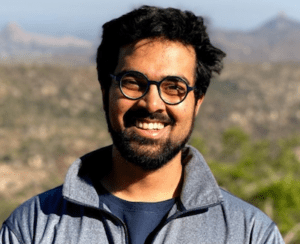Startup Spotlight profiles startups founded by current Berkeley Haas students or recent alumni.
Lastbit
Co-founders: Bernardo Magnani, MBA 20, and Prashanth Balasubramanian

Economist and former McKinsey consultant Bernardo Magnani, MBA 20, spends a lot of time thinking about the meaning of money and how it regulates societies and human behavior. That fascination—and a drive to shake up the international payment industry— led him to early bitcoin user Prashanth Balasubramanian, and fintech startup Lastbit. In this interview, he discusses how he fell into entrepreneurship at Haas and wound up making it into the prestigious Y Combinator accelerator.
What does your startup do (in about 20 words)?
Lastbit is building a payment platform to enable cheap and instant cross-border settlements leveraging the Bitcoin Lightning Network
How did you get started in entrepreneurship at Haas?

When I came to Haas, I didn’t really know I wanted to be an entrepreneur. I didn’t even take a single entrepreneurship-related course during my MBA program. Nevertheless, I was very clear about the fact that I wanted to work close to financial institutions and payments.
I came to business school sponsored by McKinsey, and despite the fact that my experience with the consulting firm was very positive, I was having doubts about whether it was the right platform for me to drive change.
During my summer internship, I worked for one of the biggest financial institutions in South America, looking for an alternative path. I had a beautiful experience, leading three teams and nine people in digital transformation initiatives. But again, I didn’t feel that was my path. I wanted to do more things, faster.
Following my intuition, I came back to Haas determined to explore entrepreneurship. I reached out to Santiago Pezzoni, Santiago Freyria, and Francesco Dipierro, co-founders of StEP, who are now dear friends. I had heard amazing things about the program and felt that joining a rising project at the heart of the business school was the best way to learn. Eventually, I became part of StEP’s leadership team and fell in love with entrepreneurship.
Where did you meet your co-founder Prashanth Balasubramanian?

After joining StEP, I knew I wanted to find an opportunity with a fintech startup. I first heard about Lastbit and Prashanth through SkyDeck. I read everything I could find online about Prashanth and his project. I immediately felt connected to his story, values, mission, and even his love for heavy metal music. I had to meet him.
Intending to meet him, I went to my first and last networking event of my MBA. He was not there. I was bummed. Eventually, I found him and we started working together almost immediately. I never looked back after that.
Today, I’m very proud of our partnership and feel that we complement each other perfectly. On paper, we have pretty much no overlap and very different backgrounds, but our drive, vision, and values are pretty much the same.
Where did the idea for Lastbit come from?
Prashanth decided to start Lastbit when he was studying for his Master’s in Computer Science at ETH Zurich. While in Switzerland, he faced a lot of challenges moving money from India to pay his tuition and eventually decided to use Bitcoin.
Despite its potential, Prashanth realized that Bitcoin was still very far from delivering on its promise of being a new viable monetary system. Transactions were too slow and expensive, and using Bitcoin for real-world transactions was close to impossible. He decided to leave his Master’s program to start Lastbit with the mission to take Bitcoin mainstream, leveraging the Lightning Network, a technology that makes sending as little as a dollar instantly across the globe economically viable.
Why did the idea appeal to you personally?
Growing up in Mexico I saw how broken financial services are and I’ve been trying to find a way to solve this. When I met Prashanth, I immediately understood what cryptocurrencies such as Bitcoin could mean for financial services. I’ve worked close to banks for around seven years and had never seen something nearly as exciting. I believe cryptocurrencies are the only credible promise to drive a paradigm shift in financial services.
What’s the Lightning Network and why is it so important?
The Lightning Network is a communication protocol built on top of Bitcoin that allows money to be sent between two parties instantly for very low fees without requiring a middleman to settle the transaction. The Lightning Network as a technology is meaningful for financial services because it’s arguably the fastest and most cost-effective way to settle transactions in the history of digital payments.
The Lightning Network as a technology is meaningful for financial services because it’s arguably the fastest and most cost-effective way to settle transactions in the history of digital payments.
Disrupting cross-border payment settlements with the Lightning Network could mean that sending and receiving money across the globe to anyone, anywhere, could be as simple and fast as paying your friends for lunch using Venmo or CashApp.
International payment settlements have seen no meaningful disruption in almost 50 years. Today, most global payments are still settled using the guidelines set by SWIFT, a protocol developed in the 1970s that isn’t up to par with the requirements of an economy that’s become more digital and global. SWIFT transactions can take five days or more and can cost $50 or more to settle, whereas Lightning transactions are instant and cost less than a penny each.
Getting into Y Combinator is exciting for any startup. What was the virtual experience like?
Quite frankly, one of the best experiences of my life. Honestly, I was a little skeptical about this batch being remote and I questioned how much value it would have for us. But for me, as a first-time founder, it was very transformative. It provided both unparalleled knowledge and access to one of the deepest networks in Silicon Valley.
Y Combinator marked a before and after for us. We just had our demo day (an event held twice a year when startups present to investors) and it’s been crazy. The interest we got is overwhelming. It feels like a dream come true.
What’s been the biggest challenge for Lastbit so far?
The biggest challenge has to be regulation. Cryptocurrencies have operated outside of the scope of traditional financial regulation for most of their history. Nevertheless, regulation has started to emerge globally.
We take regulation very seriously and are always looking to be one step ahead of what’s strictly required from us. Nevertheless, there is no real guarantee that regulation in the future will be favorable for businesses like ours. For example, some countries, including India, are attempting to ban cryptocurrencies.
All taken into consideration, I believe that regulation is a good thing and for us and being proactive about it can be a competitive advantage as it was for Coinbase.
What are your goals for the next six months?
Right now we are super focused on Europe, working on enabling cheaper and faster euro-to-euro merchant payments and remittances between Europe and Africa. Our goal for the next 12 to 18 months is to grow the business enough to raise a Series A round, which may require expanding our focus to other geographies, such as the USA.
The long term vision is to build a platform that connects all the major international payment corridors so that businesses across the globe can build payment solutions using our infrastructure. Think about Stripe, but for cross-border payments.